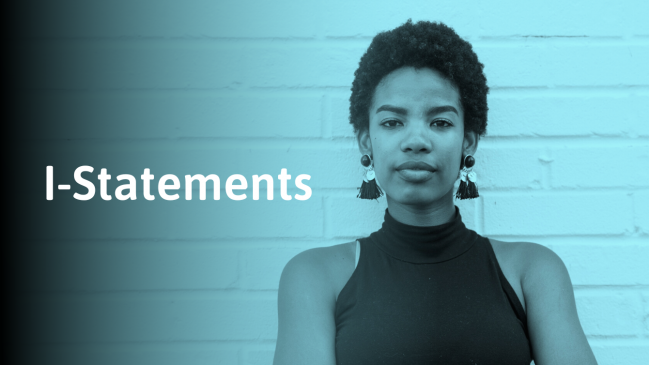If you’ve been looking at ways to improve your relationships, you might have come across the idea of I-statements. They’re often suggested as a way to help you resolve conflict in a respectful, constructive manner.[1]
We’re going to take a good look at I-statements: what they are, how they work, and when you shouldn’t use them.
Sections
What is an I-statement?
An I-statement is a sentence beginning with the word “I” that tells another person how you are feeling in a clear, constructive, and empowered way. For example, you might say, “I feel…” or “I become nervous when….”
I-statements are a powerful tool to help you express your feelings to someone else without assigning blame or making them feel defensive.[2] We usually use them when we’re saying something that the other person is likely to be upset by, but they’re also useful when you want to show that you’re taking full responsibility for your feelings.[3]
Why are I-statements important?
I-statements show that you want to have a constructive, blame-free conversation and that you are willing to take responsibility for your own feelings. This gives you a headstart when you want to have a productive conversation and find a mutual solution.[4]
When you start a conversation by talking about the other person’s actions, you’re sending the message that they’re the problem. For most people, this immediately leads to them becoming defensive and trying to deflect blame back onto you. The conversation becomes like a game of emotional tennis, with each of you trying to land the blame on the other person’s side of the net.
A productive conversation comes when you’re both working together to explore a problem. You’re more like detectives trying to understand the root cause of what went wrong. You show each other your ‘clues’ in the form of your feelings and reactions and try to find a solution that makes both of you happy. An I-statement is an important tool to help you give the other person the information they need about your experiences.
Don’t underestimate how powerful it can be when you take responsibility for your own emotions.[5] For example, saying, “You make me angry when you…” doesn’t take any responsibility for your emotional reaction. It sounds as though your anger is a passive, inevitable consequence of their actions, but it isn’t.
When you say “I get angry when…” you are making space for the possibility that you might be able to react in a different way. You’re being honest about your feelings, but you’re not presenting them as being something the other person did to you.
Try listening to the people around you when they’re talking about their emotions and thinking about how many people are taking responsibility for their own emotions. You might be surprised at how rare it is and how you find yourself responding differently when you hear someone who does.
How to create a good I-statement
Communicating your feelings using I-statements can feel strange and unnatural, especially during arguments. We’re going to break down the steps to help you form your I-statements. Once you’ve practiced these instructions, using I-statements will eventually become natural for you. Here is how to create a good I-statement.
1. Identify your feelings
You can’t explain your feelings to someone else if you haven’t thought about what those feelings actually are. When you’re thinking of an I-statement, always start by trying to understand your emotions.
Journaling and mindful meditation can be helpful if you struggle to understand how you feel.[6] Keeping a journal can be especially helpful as you can look back at what you’ve written to see patterns in your emotional responses.
You may need to take some time to calm down following an argument before you can really unpack your problems and be ready for positive communication. What you are feeling is the first part of your I-statement. For example, you might begin an I-statement by saying, “I feel annoyed…” or “I feel lonely….”
You might find this article on improving self-awareness helpful.
2. Describe the behavior that bothers you
I-statements are focused on you and your feelings, but you’re still trying to get someone else to change their behavior. They need to understand what the problem is if you want them to change. Describing the behavior that’s causing the problem is the second part of your I-statement.
The trick to describing problematic behavior in an I-statement is to be as factual and non-judgemental as you can. Try to stick to objective observations. For example, saying that someone is lazy is making a value judgment about their character and their motivations. Saying that they don’t put their dishes in the dishwasher is a simple fact.
Describing behavior gives the other person a chance to explain something you might not have realized. For example, saying that they’re lazy will probably leave them feeling defensive. If you mention that they don’t put dishes in the dishwasher, they might explain that they’ve hurt their knee and that chore is painful for them.
Check whether your statement is only about a specific behavior by imagining that you have a CCTV recording of your conversations. Would you be able to prove that they were wrong? CCTV couldn’t prove that they weren’t listening to you during a conversation, but it could prove that they were playing a game on their phone.
3. Talk about how their behavior affects you
We start our I-statements by talking about how we feel, but there’s often more going on than just one feeling. Talking about the effect a problem is having on you gives you a chance to express some of the other thoughts and emotions that come into play.
For example, you might be scared when your partner yells at you because it brings back memories of being bullied at school. Explaining the effect their behavior is having on you gives them a deeper understanding of you and your feelings.
Again, be careful not to assign blame when talking about the effects on you. Your I-statement is all about accountability and taking responsibility. Your partner isn’t to blame for other students bullying you at school, but they do need to know the effects of their actions.
Not all I-statements will have a part that talks about the effect of the behavior on you. If it does, this is the final part of your I-statement.
4. Check you are being assertive
A good I-statement is empathetic but also assertive. Check your language to make sure that you’re not minimizing your feelings or trying to prioritize the other person’s feelings over your own.
Phrases such as “It’s nothing really” or “I’m probably overreacting” tell the listener that your needs aren’t important and that there’s no need to change. Your feelings are important, and you need to be able to talk about them.
5. Practice
Talking about our problems in I-statements isn’t natural for most of us. The more you use them, the more natural they will become. Over time, they may also change how you think about conflict in your life.
I-statements work best when both people in the conversation are using them. They’re often used in couples’ therapy to help us get used to talking about our own needs and listening to the other person.
If you’re trying to work through issues in a particular relationship, it might be helpful to discuss using I-statements with the other person. You can help each other to improve your communication style and understand more about each other in the process.
You can also learn more about improving communication in relationships.
Examples of good I-statements
Making I-statements isn’t easy, especially when you first start, because they make you feel vulnerable. Here are some examples to help you to practice:
| You-statement | I-statement |
| You never listen to me. | I feel lonely and unimportant when you look at your phone when we talk because I worry that you’re not interested in the conversation. |
| You always leave me out. | I feel hurt when I’m not invited to events because it feels like I’m not welcome. |
| You need to pay attention | I need reassurance that you’re listening to me because what I’m about to say is really important. |
| You’re nagging me. | I don’t feel trusted when you remind me of things I’ve agreed to do. That hurts because I want to be someone you trust. |
| You don’t care about me. All you care about is going out with your friends. | I’m feeling ignored and as if I’m not a priority. I feel like I’m not good enough when you postpone seeing me to spend time with your friends. |
How I-statements can be misused and what to do about it
I-statements are generally a valuable tool, but toxic or abusive people can sometimes misuse them in an attempt to manipulate and control you. We’re going to look at how to identify when this is happening and what to do about it.
1. They use you-statements in disguise
Toxic people may try to make it harder for you to defend yourself against their accusations by starting them with the word “I.” They might say, “I feel like you’re rude and disrespectful,” or “I’m really hurt that you abandoned me and never make time for me.” These are not actually I-statements.
To see whether something is an I-statement or an accusation, try removing the first few words from the sentence. If the message is basically the same, it’s probably a you-statement pretending to be an I-statement.
For example, there isn’t really much difference between “I feel like you’re rude and disrespectful” and “You’re rude and disrespectful.”
What to do about it
How you respond to you-statements in disguise usually depends on whether you think the other person is trying to manipulate you intentionally or not.
If you think they’re genuinely trying to communicate well, you can try to help them communicate their feelings better. Try asking questions about how they feel and showing them that you do care about their feelings. Explain calmly that you’re feeling a little attacked, and consider asking for some time to calm down to help you discuss the problem more constructively.
Depending on the relationship you have with them, you might be able to encourage them to do some research into communicating their needs better. If they’re someone you know well and have a trusting relationship with, you could talk about the principles of I-statements and how they work best. You could even suggest that they read this article.
If you suspect that they’re trying to manipulate you, it’s often better to disengage from the conversation. Narcissists in particular use this technique and can thrive off the conflict that it can cause.[7]
If you have to engage (for example if they are a work colleague, or your boss), remind yourself that they’re not trying to find a constructive solution to the problem. Their agenda is more likely to be to blame you entirely… or even make you blame yourself.
In this case, try to take an objective view of your behavior. Consider asking a trusted friend, or even a therapist, for a second opinion as to whether you are in the wrong. Apologize for any mistakes you genuinely believe you have made. Be polite but non-committal when they complain about situations where you don’t believe you did anything wrong.
For example, you could say, “I understand that it felt that way,” or “That wasn’t my intention.”
2. They close down the discussion
When someone is using I-statements as a weapon, they often use their feelings as a way to shut down the conversation. This behavior is hurtful, invalidating, and often manipulative.[8]
For example, if they say, “I feel like you’re really disrespectful,” you might explain why you don’t believe your actions were disrespectful. They would then try to take control of the conversation by saying, “I’m just telling you how I feel.”
None of us can tell someone else how they feel about a situation, but it’s not OK to use that fact to shut down a discussion, especially if they started the conversation.
What to do about it
If you feel someone is using this argument in bad faith, it’s often better to disengage. Finding a good resolution to a conflict requires both people to work together. Using I-statements to shut down a conversation like this is an attempt to avoid taking responsibility for what they have said. They’re showing you that they’re not willing to work with you to make things right again.
If you need to work with them to find a solution, try to move the conversation toward concrete actions rather than allowing them to control you with discussions about their feelings. You could say, “I respect that’s how it feels to you, just as you respect that it feels different to me. Given that we feel very differently about it, let’s focus on trying to agree on what we can do differently to make this work.”












Please stop writing “articles”. No one needs to read these, they are just a board to paste betterhelp ads onto and think of the harm every click on betterhealth causes. Betterhelp is a menace and so are you.
No one forced you to this page. You do not speak for the majority of us.